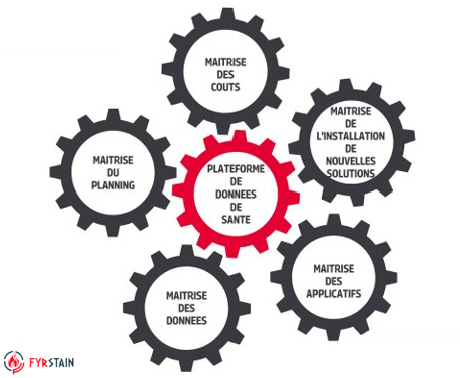Context
The limitations of interoperability capacities are recurrent in health structures which suffer from not optimizing the interaction between their applications as well as with their close partners.
This is why the HL7® FHIR® (Fast Health Interoperability Resources) standard – the international standard defined by HL7 – now appears to be the most suitable for developing and implementing healthcare interoperability simply and quickly.
At the international level, the United States explicitly recognizes this standard as an emerging standard for the exchange of health data. Thus, in 2019, 84% of hospitals had adopted it and it is now mandatory. In addition, the European health data space is also being built on this standard.
However, in France, adoption by establishments remains low because there are still challenges and problems to be solved :
- Lack of expertise on the subject;
- Lack of guaranteed data uniformity;
- Lack of autonomy of structures that depend on publishers’ schedules;
- Lack of strategy to manage the different versions of FHIR®;
- Prohibitive cost of adaptation to the standard of current solutions.
Control of the data exchanged remains therefore difficult to access, especially since some older standards, such as HL7v2, do not offer any history or storage solutions.


Facilitate exchanges between services
The « Health Data Sharing Platform » aims to promote the use of health data and increase the possibilities for their exploitation.
It streamlines the work of healthcare practitioner, management of the health system, monitoring and patient information.
At the heart of the production: the international FHIR® standard. It provides a well-documented, easy-to-maintain, and future-proof interoperability framework for internal and external applications. It also meets the need for a common language to deal with the explosion in the number of interlocutors and strengthens the data sovereignty of health structures.
In this reliable and stable environment, the platform provides greater control of data and internal organization (reduced costs, better planning management, synergy between applications and installation of new solutions). Ultimately, this improves the quality of life at work for healthcare professionals as well as that of patient care.
New uses
Our approach in order to meet the needs of the Toulouse University Hospital, as for any health establishment presenting similar problems, was to reflect on the problem as a whole and to identify a certain number of potential actors in order to discuss with them. We proposed a flexible and scalable architecture and simple use cases to serve as proof of concept. We studied the technical appetite of local teams and the existing technical environment in order to put in place only the bricks necessary for these use cases.
The « Health Data Sharing Platform » governs these new uses that can be adapted to all health structures.
Among them, the compliance of prescriptions and additional examinations is made possible by the implementation of a decision-making aid. The latter takes into account all the patient’s medical information, such as their history or known allergies. The patient’s agenda, which has become transferable, allows appointments to be made for a professional from another establishment. The sharing of patient identity makes it possible to link the different health establishments which can exchange data through the circle of care.
The platform optimizes the use of the circle of care and the liaison book, thus allowing exchanges between city doctors and the hospital and provides for circulating notes between health professionals. It feeds the HDW (Health Data Warehouse) and pools the terminology service, mapping, consent and structures (hospital services, buildings, etc…). CIO data is also retrieved by the platform.

Secure data
Data hosting poses problems of sovereignty and confidentiality of sensitive data such as medical data.
With the health data platform, no more pushing data to all partners without control. It makes data available and applications only access what they need !
The data is sorted and stored in storage spaces according to their functional scope. This allows the platform to adapt to usage and protect access to its data.
No application ever directly accesses the core of the platform. The reverse-proxies put in place provide a layer of protection.
The implementation of a security audit keeps connection traces and detects unauthorized access attempts.
All internal and external applications to the establishment will be able to query the platform to use the data. No extra effort to synchronize them !
Discover Fyrstain solutions on FHIR® (Link: Our services).